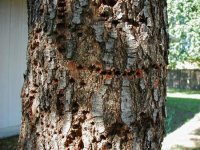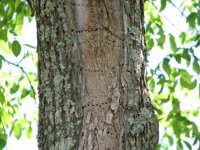Bird,
From what others have said & my online research, it seems the most probable explanation is ...
"Q. Help! Something is boring holes in my silver maple tree. There are four holes at a time in a horizontal line. These holes are a little bigger than a pencil eraser and deep enough that the tree is oozing lots of sap. What could be doing this? Will my tree die? Do I need to plug the holes and with what? What can I do to prevent this from continuing? It has happened three times already! Thanks for any insight you can provide, because I really don't want to lose my tree.
-- Terry Emmons
A. It seems mysterious, doesn't it? There's no sign of an insect, but obvious holes in the tree! The telltale clue is the horizontal pattern of the holes. Boring insects tend to make a random pattern of emergence hole. Only a vertebrate with a brain would systematically make a line of holes. It's probably a sapsucker, a type of woodpecker.
Their strong, pointed beaks are used for digging insects from trees, excavating nesting cavities and for "drumming." Since woodpeckers do not have true "songs," they use sharp calls and perform rhythmic tapping (better known as drumming) with their beaks on surfaces, such as dead tree limbs, metal poles and building siding to attract a mate or announce territorial boundaries. Both male and female woodpeckers drum. It is primarily this drumming behavior that may cause serious problems for homeowners.
The yellow-bellied sapsucker bores neat rows of one-quarter inch holes spaced closely together. Most often, they bore holes on trees rather than structures, since they feed on sap.
Several options are available to you to reduce or prevent woodpecker damage. It is best to make use of several of these non-lethal methods at the same time, as soon as the damage begins.
Woodpeckers can be frightened from the area by scare devices such as banging pots, clapping hands or spraying the birds with a high-pressure water hose. Using high-reflective mylar tape (one-half inch width) has also been successful. Mylar balloons can be used in a similar manner.
You can exclude the woodpeckers by mounting fine mesh netting or screening on the tree or by covering the affected area with heavy (3-plus mm) plastic sheeting. This will keep the birds from being able to grip the rough texture of the tree with their claws. They cannot peck or drum if they cannot hang onto the surface of the tree. This can be put up or removed as needed.
Do not plug the holes since this can trap bacteria and moisture within the holes, leading to decay. Trees heal by the formation of scar tissue. Recent research throws doubt on the value of the practice of painting a wound and is no longer recommended. .."


